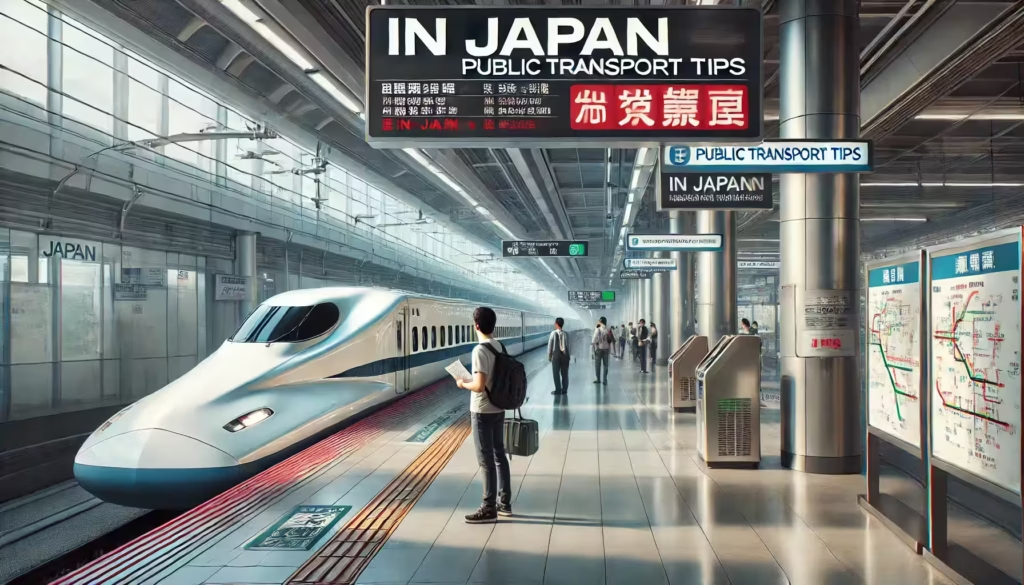Japan is famous for many things: cherry blossoms, sushi, anime, and futuristic cities. But if there’s one thing that truly sets Japan apart, it’s the country’s public transport system.
Reliable, clean, and impressively punctual, Japan’s trains, buses, and subways make getting around a breeze. However, for first-time visitors, this world-class system can feel overwhelming. From navigating ticket machines to understanding Japan Rail Passes, there’s a lot to learn.
Public Transport in Japan

Don’t worry! This guide will take you through the best tips for using public transport in Japan so you can explore the country like a pro. Let’s break it down, step by step, so you can travel with ease and confidence.
1. Understanding Japan’s Public Transport System
Japan’s public transportation network is vast and incredibly efficient, connecting urban areas, rural villages, and everything in between. To fully understand it, you’ll need to familiarize yourself with the different options available, how they work, and how to choose the best mode of transport depending on your travel plans.
Trains and Subways
Japan’s train system is the backbone of its public transport, offering everything from local commuter lines to high-speed bullet trains. Here’s a breakdown:
- JR (Japan Rail) Trains: These trains are operated by the Japan Railways Group and are divided into several regional branches like JR East, JR West, and JR Kyushu. JR trains include local, rapid, express, and Shinkansen services (bullet trains). If you plan to travel long distances, JR trains are your best bet.
- Shinkansen (Bullet Trains): The Shinkansen is Japan’s iconic high-speed train network. It connects major cities like Tokyo, Osaka, Kyoto, and Hiroshima in record time. With speeds of up to 320 km/h, the Shinkansen is not just fast—it’s clean, quiet, and incredibly comfortable.
- Subways: Cities like Tokyo, Osaka, Kyoto, and Fukuoka have extensive subway systems that serve as the most convenient way to get around urban areas. The subways are punctual, clean, and easy to use once you get the hang of the maps and routes.
- Private Rail Lines: In addition to JR trains, private railway companies operate smaller lines that serve specific regions or suburbs. Popular companies include Keio, Odakyu, and Tobu in Tokyo, and Kintetsu in the Kansai region.
Buses
While trains dominate the transportation scene, buses also play an essential role:
- Local Buses: These are perfect for short-distance travel within cities, towns, and rural areas. You’ll often use buses in smaller towns where trains aren’t available.
- Highway Buses: For long-distance travel, highway buses are a cost-effective alternative to Shinkansen. Companies like Willer Express and JR Bus offer comfortable seats, free Wi-Fi, and even overnight options.
Taxis
Though taxis are a more expensive option, they’re still useful, especially at night when trains and buses stop running. Japanese taxis are famously clean, reliable, and safe. For non-Japanese speakers, showing your destination on Google Maps or writing it in Japanese helps avoid confusion.
IC Cards
IC cards like Suica, Pasmo, and ICOCA make traveling a breeze by eliminating the need to buy individual tickets for each journey. These rechargeable smart cards work across trains, buses, subways, and even for purchases at convenience stores or vending machines.
Key Benefits of Japan’s Transport System
- Punctuality: Trains and buses run on time to the second. If a train is late, the station staff will issue a delay certificate for work or school purposes.
- Cleanliness: Public transport in Japan is spotless—it’s normal to see workers clean trains at each stop.
- Safety: Japan’s transport is incredibly safe, even late at night. Stations are well-lit, and train staff are always available to help.
Quick Tip: Get familiar with Japan’s transportation apps like HyperDia, Google Maps, and Navitime. These tools are lifesavers for planning routes, checking schedules, and estimating fares.
2. The Japan Rail (JR) Pass: Is It Worth It?
If you’re planning to travel across Japan, the Japan Rail Pass is a game-changer. It can save you both time and money while providing unparalleled access to Japan’s world-class rail system.
What is the JR Pass?
The Japan Rail Pass is a special travel pass available to foreign tourists. It provides unlimited access to JR trains, including:
- Shinkansen (bullet trains, except for Nozomi and Mizuho services).
- Local and regional JR lines.
- JR buses and some JR ferry routes, such as the ferry to Miyajima.
The pass is available for 7, 14, or 21 consecutive days, making it perfect for travelers planning extensive journeys.
Is the JR Pass Worth It?
The value of the JR Pass depends on your itinerary:
- Best for Long-Distance Travel: If you’re visiting multiple cities like Tokyo, Kyoto, Osaka, and Hiroshima, the pass is a fantastic deal. A single round trip between Tokyo and Kyoto almost covers the cost of a 7-day pass!
- Not Ideal for City Travel: If you’re staying in one city, like Tokyo, and using local trains or subways, the JR Pass won’t save you much. Instead, IC cards like Suica or Pasmo are more cost-effective.
- Flexibility: The JR Pass allows you to make last-minute plans, as seat reservations on Shinkansen are free for pass holders.
How Much Does the JR Pass Cost?
The prices for the standard JR Pass (as of 2024) are approximately:
- 7-Day Pass: 50,000 yen (~$340 USD)
- 14-Day Pass: 80,000 yen (~$545 USD)
- 21-Day Pass: 100,000 yen (~$680 USD)
Where to Buy the JR Pass
- Before Your Trip: Purchase the JR Pass online from authorized vendors. It’s usually cheaper when bought outside Japan.
- In Japan: JR offices sell the pass, but prices may be slightly higher.
- Exchange Process: Once in Japan, exchange your voucher for the physical pass at designated JR stations (like Narita or Haneda Airports, Tokyo Station, or Kyoto Station).
How to Use the JR Pass
- Present your pass at the manned ticket gate to enter stations.
- Reserve your Shinkansen seat in advance for free at JR ticket offices or machines.
- Enjoy unlimited rides on eligible trains, buses, and ferries.
Additional Benefits of the JR Pass
- Cost Savings: For multiple Shinkansen trips, the pass pays for itself.
- Convenience: No need to buy individual tickets for each journey.
- Ease of Use: Seat reservations are straightforward and free, making travel stress-free.
Pro Tip: If you plan to explore specific regions like Kansai or Hokkaido, consider regional JR passes, which are cheaper and cater to shorter itineraries.
Example Itinerary: A 7-day JR Pass easily covers the following trip:
- Day 1-2: Tokyo
- Day 3: Day trip to Nikko or Hakone
- Day 4-5: Kyoto
- Day 6: Hiroshima and Miyajima
- Day 7: Return to Tokyo
With this itinerary, you’ll save significantly compared to buying individual tickets.
3. Mastering IC Cards: Suica, Pasmo, and ICOCA
IC cards are your best friend when it comes to using public transportation in Japan. Here’s why you’ll love them:
- They work seamlessly across trains, buses, and subways.
- No need to fumble with cash or tickets—just tap and go.
- You can even use them for shopping at convenience stores and vending machines.
How to Get an IC Card
You can purchase IC cards like Suica, Pasmo, or ICOCA at train stations, airports, and ticket machines. Cards require a refundable deposit (usually 500 yen).
How to Use an IC Card
- Tap your card on the reader at station gates or bus entrances.
- Reload your card at ticket machines or convenience stores.
- Don’t forget to tap out when exiting!
Insider Tip: Mobile-savvy travelers can use Apple Pay or Google Wallet to store a virtual Suica card on their smartphones.
4. Navigating Train and Subway Stations
Japan’s train stations can feel like mini-cities, especially in places like Tokyo and Osaka. Here are a few tips to navigate them with ease:
Follow the Signs
- Train stations have clear signage in English and Japanese. Look for directions to platforms, exits, and ticket machines.
- Different train lines are color-coded to make navigation simple.
Ticket Machines
- If you don’t have an IC card, buy tickets at vending machines.
- Ticket prices are displayed on maps above the machines—find your destination and pay the corresponding fare.
Platform Etiquette
- Stand in designated lines while waiting for the train.
- Let passengers exit the train before boarding.
- Keep noise to a minimum—it’s common courtesy in Japan.
Pro Tip: Use station maps (available online or at stations) to locate restrooms, lockers, and food stalls.
5. Riding the Shinkansen: Japan’s Bullet Train
No trip to Japan is complete without experiencing the Shinkansen. Traveling at speeds of up to 320 km/h, these trains make long-distance travel quick and comfortable.
How to Ride the Shinkansen
- Reserve your seats in advance if you have a JR Pass (free) or buy tickets at JR offices or machines.
- Arrive at the station early. Shinkansen platforms are separate from regular train platforms.
- Follow signage to your car number and seat.
What to Expect Onboard
- Spacious seats with plenty of legroom.
- Snack trolleys selling bento boxes, drinks, and souvenirs.
- Power outlets and clean restrooms.
Etiquette Tip: Keep noise to a minimum and turn phone calls to silent mode. The Shinkansen is a peaceful place!
6. Using Local Buses
While trains dominate Japan’s transportation scene, buses are invaluable for exploring areas like rural towns or neighborhoods.
How to Ride a Bus in Japan
- Enter through the rear door and take a numbered ticket (if needed).
- Pay when exiting through the front door by tapping your IC card or inserting cash.
Understanding Bus Fares
- Fares vary depending on the distance traveled. Check the fare chart near the driver.
- Display screens show your stop number and corresponding fare.
Pro Tip: Always have small bills and coins handy for buses that don’t accept IC cards.
7. Taxi Tips for Late-Night Travel
While public transport in Japan is fantastic, trains and subways don’t run all night. That’s where taxis come in handy.
How to Use a Taxi
- Look for taxis with a green light on the dashboard (indicating availability).
- Doors open and close automatically—wait for the driver!
- Most taxi drivers don’t speak English, so show your destination on Google Maps or a written address in Japanese.
Taxi Apps
Apps like GO Taxi or JapanTaxi (similar to Uber) are useful for booking taxis in major cities.
Quick Tip: Taxis are reliable but expensive. Use them sparingly or share rides when possible.
8. Travel Etiquette: Do’s and Don’ts
Respecting local etiquette is key when using public transport in Japan. The country is known for its politeness, and these unspoken rules ensure everyone has a smooth and pleasant experience.
Do’s
- Stand in Line: Whether at train platforms or bus stops, always queue in an orderly fashion. Look for floor markings that show where to wait.
- Let Passengers Exit First: Before boarding a train or bus, allow passengers to exit completely.
- Offer Seats to Those in Need: Be mindful of priority seats reserved for the elderly, pregnant women, and those with disabilities. If you see someone who needs the seat more, offer it to them.
- Keep Quiet: Public transport in Japan is remarkably quiet. Keep conversations at a low volume and avoid phone calls.
- Use Headphones: If you’re listening to music or watching videos, always use headphones to avoid disturbing others.
- Mind Your Luggage: Keep large bags in designated areas or hold them close to avoid taking up unnecessary space.
- Be Punctual: Arrive at your platform or stop early to avoid missing your ride.
Don’ts
- Don’t Eat or Drink: Eating and drinking on local trains and buses is considered rude. However, eating is perfectly fine on long-distance Shinkansen trains.
- Avoid Loud Phone Calls: Speaking on the phone in public transport is a big no-no in Japan. Put your phone on silent mode.
- Don’t Block Doors: Always step aside when the doors open to allow people to get on and off smoothly.
- Avoid Littering: Public transport is impeccably clean, so always take your trash with you.
- Don’t Recline Seats Without Checking: On long-distance buses or Shinkansen, be mindful when reclining your seat. A polite glance or quick word to the person behind you goes a long way.
Fun Fact: Japanese train staff will bow when entering or exiting train cars—a gesture of respect for passengers.
9. Apps to Make Your Life Easier
Japan has some fantastic apps that make navigating public transport a breeze, even if you don’t speak Japanese. Here’s a closer look at the must-have apps:
1. HyperDia
HyperDia is a highly reliable app for planning train journeys. It provides detailed train timetables, fares, transfer times, and route suggestions. It’s perfect for Shinkansen travelers or those with a JR Pass.
2. Google Maps
Google Maps is invaluable in Japan. It covers walking routes, train schedules, bus stops, and station exits with great accuracy. It’s particularly useful for navigating subway systems in cities like Tokyo and Osaka.
3. Navitime for Japan Travel
Navitime is tailored for tourists and offers:
- Multilingual route searches (English, Chinese, Korean).
- Offline maps and navigation options.
- Suggested travel itineraries and local guides.
4. JapanTaxi
JapanTaxi works like Uber and allows you to book taxis conveniently, especially in busy areas where hailing a cab might be difficult.
5. Suica or Pasmo Apps
If you’re tech-savvy, you can use apps to store IC cards like Suica on your smartphone. This makes reloading and managing your balance incredibly easy.
6. Yurekuru Call
This app sends earthquake alerts and safety updates—a helpful tool if you’re visiting areas prone to seismic activity.
Pro Tip: Download these apps in advance and ensure you have a pocket Wi-Fi device or a local SIM card to stay connected throughout your trip.
10. Final Tips for Smooth Travel
Before you hit the road, here are a few final tips for using public transport in Japan:
- Start Early: Trains and buses can get crowded during rush hour (7-9 AM and 5-7 PM).
- Keep Cash: While IC cards work most of the time, some buses still require cash.
- Stay Calm: Japan’s public transport can seem daunting at first, but it’s easier than it looks. Don’t be afraid to ask station staff for help!
Conclusion
Navigating Japan’s public transport doesn’t have to be stressful. With a little preparation, you’ll quickly master the trains, buses, and Shinkansen like a local. Remember to grab your IC card, download helpful apps, and enjoy the journey—because in Japan, even getting around is an experience in itself.
For more travel tips and guides, check out other articles on JapanTravelDreams.com. Whether it’s hidden gems, itinerary ideas, or local insights, we’ve got you covered!



